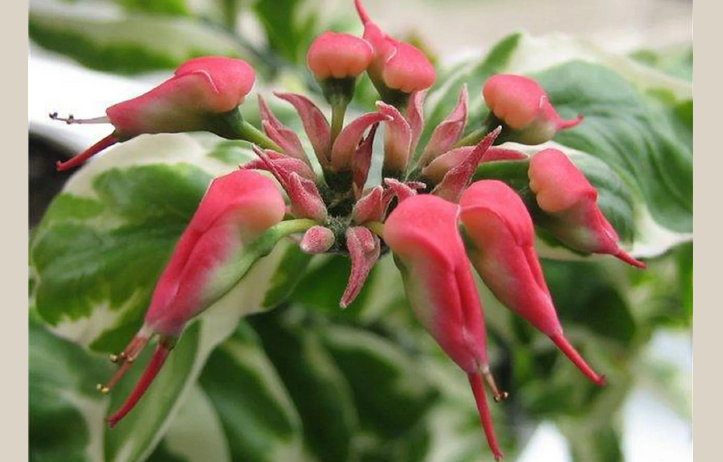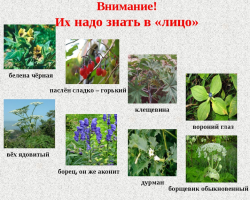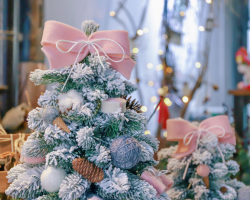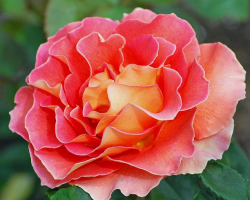If your at home grows a room flower for a pedantus, then read the article. It describes how to properly care for the plant.
Content
- What kind of flower is Pedilantus: a description, where is its homeland, a photo of a flowering pedantus
- Pedilantus: species
- Pedilantus Titimaloid: what is this flower, why is popular for growing a house?
- House Flower Pedilantus - you can keep at home: benefits and harm to humans and pets
- Ficus pedilantus: signs and superstitions
- Home flower with green leaves Pedilantus: how to care at home?
- Location and lighting of the pedantus
- Pedilantus growing temperature
- Humidity and watering of the soil for pedilantus
- Top dressing
- House plant Pedilantus: which pot is suitable?
- Pedilantus transplant
- Flowering and pruning of pedilantus
- Indoor flower pedilantus - reproduction at home: cuttings, seeds
- Pedilantus drops the leaves - proper care: what to do if the leaves fall?
- Ficus Benjamin and Pedilantus: What is the similarity?
- Video: Pedilantus. Features of care
Home flowers add positive to our lives. But, before starting the plant at home, you need to find out as much information as possible about it. Indeed, good and proper care is important for the home flower, otherwise the plant may die. For example, Pedilantus -This is a beautiful flower that many amateur gardeners have at home.
Read in another article on our website about how to transplant a room flower correctly. You will find instructions in it and other useful information.
Care Pedilantusit should be special - good lighting, proper top dressing and transplantation, and much more. All this must be known, then the leaves will always be green and beautiful. Read more below.
What kind of flower is Pedilantus: a description, where is its homeland, a photo of a flowering pedantus

Pedilantus - From lat. Pedilanthus — “Pedilon” - “shoe”, “anthos” - “flower”. The flower received a similar name due to its uniqueness. This is a plant belonging to flowering decorative shrubs, as well as to some trees of the family of the Polish from lat. Euphorbiaceae - "Contains juice".
In some sources, you can also find names such as "Jacob’s Ladder" (from the English "Jacob Stais"). Such specific names can be explained by the external features of the flower - a zigzag shape of the stem.
In nature - these are quite small trees high usually up to 3 meters. The stems are cylindrical, dull gray or dark green. If we talk about plants that grow in culture, then the diameter of the stem under normal conditions on average reaches 2 cm. As for the shape of the leaves, it is ovate, wavy, a little pointed at the ends in the pedilantus.
The official homeland of this plant - the tropics of America. Mostly northern, southern and central regions.


In the photo of the flowering pedantus, it can be noted that the flowers are somewhat reminiscent of the heads of birds-long, with a beak. They are red, sometimes pink shades. In general, the flower is very unusual, which is why it has become so popular among lovers of indoor plants.
Pedilantus: species

In the genus of Pedilantus, you can count approximately 15 varieties. The most famous species of them:

- Pedilantus Finnka (from lat. Pedilanthus Finkii) -Bright green, tall plant with a dark middle.
- Over time, the aging of the foliage brightens greatly.
- The usual habitat is hot tropical forests.
- It is worth highlighting that such a shrub, the lower part of which does not branch, grows well on loose and light substrates.

- Pedilantus large -fruited (from Lat.pedilanthus macrocarpus) - Not a too attractive plant if compared to other varieties.
- This succulent is almost flourished, but has quite attractive flowers, since they can be very diverse in its color scheme.
- This species is characterized by the ability of a long preservation of humidity.

- Pedilantus is spur (from Lat.pedilanthus calcaratus) - The plant belongs to evergreen and can reach a three -meter height, has a wide crown.
- With insufficient amount of moisture, the leaves can fall very much.
- The color of these leaves under normal conditions is bright green.

- Pedilantus Koalakomanensky (from Lat.pedilanthus coalcomanensis) - This plant can be recognized by a spreading bush or a miniature tree.
- Usually such a flower lives in Mexico, namely in its mountain regions.
- The petals are characterized by very beautiful pink shades.
- The plant itself is very large, easily tolerates various weather changes.
All these species are very beautiful, but the most popular for growing a house is considered Pedilantus is thytimaloid. Why - read on.
Pedilantus Titimaloid: what is this flower, why is popular for growing a house?

It will be about the very plant that is also called the Jacob staircase. It is often used in creating a hedge, since it is great for this in its characterization of structure and adaptability to the environment. The plant changes color depending on external factors, creating incredible color combinations.
Pedilantus is thytimaloid(from lat. Pedilanthus Tithymalloides) - A very popular species of pedilantus for growing a house. Its flowers are painted in red or orange. It is worth saying that this plant selects juice that is used in the preparation of various pharmaceuticals. Although as for the milky juice, it is very poisonous and may well cause allergies or irritation of the mucous membrane. The plant transfers pruning very well, which is why it deserves a separate place in the hearts of lovers of indoor plants. Read more more.
House Flower Pedilantus - you can keep at home: benefits and harm to humans and pets

Many people prove that the pedantus literally cleanses the air of different toxic impurities of negative energy, and at the same time fills the room with essential oils and a new stream of oxygen. Can I keep this room flower at home? The benefits and harms for humans and pets:
- This is exactly the plant that can be safely called a kind of “doctor”.
- They say that if you give this flower to someone, then it will certainly bring positive changes to the life of this person.
- If you place it in the office, this will bring good luck at work.
- Well, if you purchased this plant yourself. Indeed, even in this case, the flower will certainly bring something new to your life (and only good!).
As for real (physical) dangers, it is worth remembering that the flower is poisonous. You should not even think about trying what it tastes.
Important: It is strictly forbidden to let children in such plants! There will be nothing from touch, but if you get inside, a burn or even poisoning can be obtained (whether it is a wound or some mucous membrane).
Cats do not even like to come close to the pedilantus. The same situation is observed by dogs. But it is better to drive away birds. They, on the contrary, are very attracted by this plant. For them, it carries the greatest danger. After all, after the plant’s juice enters the bird's body, the bird has no guarantees for survival.
Ficus pedilantus: signs and superstitions
If something is wrong with the Pedilantus ficus, then this means that caring for it is wrong. But many believe that this is some signs. For example, it is better not to contact this flower to unmarried virgins before marriage. Many believe that in contact, the plant scares away potential grooms. And if a few days after contact, the leaves fell, then the girl will not get married soon.
Here are other signs and superstitions:
- If the ends of the leaves dry, then you should definitely pay attention to the health of your home. Perhaps one of them will soon get sick.
- In their color, the leaves darkened - to poor changes, brightened - to the good.
- The leaves of the flower do not rise towards the sun - to difficulties at work.
- The leaves are too fast and strongly yellow and fall - to an imminent separation from a loved one.
- The plant does not bloom - there are too many negative energy and family conflicts in the house.
- If the plant is careful for the plant, and it begins to rot-this is a very bad sign, which means a great danger to one of the home ones.
Despite all the signs, I would like to recall that all the signs of a flower are a direct reflection of your care for it, so you should not upset yourself once again. Instead, it is better to do a complete examination of the plant and find out what exactly is wrong with it. Read more about leaving further.
Home flower with green leaves Pedilantus: how to care at home?

In itself, a home flower with green leaves Pedilantus is very unpretentious. How to care at home?
- It can grow in any ground, but only with the presence of drainage in a pot. Use pieces of foam, pebbles or some large river sand for this.
- The main thing is to remember that the roots of the pedantus are very negative for water, which has been too stagnant. This means that drainage holes in the pot should not be clogged. If for some reason this still happened, then they should rather be cleaned. Knitting needles, for example, or even a toothpick.
Read more about the care of this beautiful flower below.
Location and lighting of the pedantus

Lighting should be bright, but without fanaticism. It is worth remembering that the pedantus loves daylight, accepts it, but only without direct sunlight. This can greatly harm the plant. Similarly with our body, when everything is useful in moderation.
Location - the flower will be good on the windowsill, on the northern or eastern side of the window. In summer, the plant can be left on the balcony, in the air. But, again, do not forget, about the hit of the sunlight. In winter, you can (even need to) use additional light.
Pedilantus growing temperature
The normal growth and development of the flower directly depends on the temperature. The most optimal option for pedilantus is approximately +25 degrees Celsius. Fresh air hit an equally important criterion for its good cultivation. During dormant (this is autumn and winter), it is best to maintain the air temperature in the interval 14-18 degrees Celsius.
Remember: Pedilantus will be uncomfortable next to heating devices. In this case, all the leaves will simply fall.
Humidity and watering of the soil for pedilantus
A huge plus of this plant is that it absolutely does not matter to the humidity. But this does not mean at all that no attention needs to be watered with watering. Especially in the summer, his soil needs to be very well monitored so that it always remains wet enough, but in no case raw. Therefore, watering pedilantus is performed in moderation - 1 time per week.
Do not forget about the features of the root system, which are very easy to give in to the process of decay. Again, in winter it is important not to dry the plant so that the foliage suddenly did not begin to fall. The leaves can be sprayed periodically (it is better only in a protracted heat.)
Top dressing

From the very beginning of April until the end of September (it is on this gap that the active growth of the plant falls), it is recommended to feed at least and no more than once every three to four weeks. In winter, the indoor flower Pedilantus does not need to be fed at all.
Remember: Nitrogen is very harmful to the plant. It leads to rotting of the root system. Therefore, it is better to limit its ingestion of fertilizers. If you use it, then only in the most extreme cases (as careful and at a minimum.)
It is proved that organic fertilizers affect the growth of pedantus. For example, a balanced complex of mineral fertilizers for cacti and succulents.
House plant Pedilantus: which pot is suitable?
Typically, for an indoor plant, a pedantus is recommended to select a low and moderately cramped pot. Ideally, such parameters as diameter and height should coincide with each other. The best material made by the pot is always considered natural ceramics, as it best passes air and moisture.
Remember: An important part of the pot is a large drainage hole.
Pedilantus transplant

The golden rule of the transplantation of the pedantus is the measure of filling the pot with its root system. But this happens quite rarely, since the roots of the pedilantus are growing no faster than the speed of the snail. In other words, the transplant is carried out only in the most extreme case - 1 time in 3-4 years.
- The best time of the year is for this - spring, since already in April the first leaves begin to develop.
- A huge pot for transplanting is not needed at all.
- It will be enough to take the container with the diameter 2-3 cm wider than the previous one.
Cleaning the roots from the old substrate occurs by removing the rotten areas and capturing up to 2 mm Healthy plant tissue. Slices processing are carried out by activated coal. In the process, do not forget about your own safety, because it is very easy to get in a “gift” - burns from plant juice.
Flowering and pruning of pedilantus

At home, the flowering of pedantus is a rather rare occurrence, but not unique. If you carefully care for, observe all the requirements for this, which in comparison with other decorative plants is not so much, then there is a probability of seeing this incredible process. It usually falls for a month of November or December. Winter peace begins after removing the last flower.
Pedilantus growth should be periodically restrained. First of all, this is necessary to give a presentable appearance. For this, the trim procedure is carried out. They usually do this in the spring (immediately after the rest period), and only in a dry room with excellent ventilation at an approximate air temperature 13-15 degrees Celsius. Again, we remind you of the importance of the security of this process for humans. The cutting of the cuts is carried out either by coal or gray.
Indoor flower pedilantus - reproduction at home: cuttings, seeds

There are two ways to reproduce the indoor flower of the pedilantus at home. The first (best in the spring or at the very beginning of summer) - cuttings (tops), second (similarly) - seeds.
Important: If you are looking for the simplest propagation method, then you should choose the cuttings, since the seeds of the pedilantus are extremely rare.
For the cuttings of the method, you will need to cut the apical branches from an adult plant with an approximate length 8-10 cm. Then be sure to free the lower part of the leaves, dry on 1-2 daysand plant in wet sand under a certain inclination, while covering each stalk with some kind of jar or bottle. The process should take place at temperature 20-25 degrees Celsius. If leaves began to appear on the cuttings, then the process is considered successfully completed.
If you managed to collect or buy seeds in some wonderful way, then it is worth remembering that the care of sowing consists in its regular ventilation and moisture as necessary. Shoots will appear only through 2 weeks. As soon as the seeds begin to germinate, the coating can already be removed. All this continue to grow exclusively in a warm and humid habitat.
Pedilantus drops the leaves - proper care: what to do if the leaves fall?

It is very unpleasant when the flower you look after, begins to turn yellow or drop the leaves. What to do if the pedilantus falls into leaves?
- It's all about caring for a plant that consists in proper nutrition (do not forget about the harm of nitrogen), regular (and correctly calculated) watering, sufficient lighting.
- Drafts also play a very large role. If they are, then the plant will not bloom, the leaves will begin to fall. This is a reaction to stress and it is completely common under such conditions.
Lever and moisturizing drops are another reason for such phenomena. There are no plants that will be beautiful and grow well and bloom if they do not water them for a long time, and then sharply pour water. Therefore, everything should be in moderation and correctly.
Ficus Benjamin and Pedilantus: What is the similarity?

Ficus Benjamin (from lat. Ficus benjamina - brilliant ficus) -an evergreen wood-bell tree, which sprouts in 25 m in height. It sprouts from the very beginning in the form of epiphyte, but continues its development in the form of a banan. The characteristic color of the barrel is gray, with fairly rare brown strokes.

This plant really looks like a pedilantus in appearance and description. Most of all, these plants are united by a common misfortune-this is a drop in leaves due to improper care. There is only one solution to this problem - it is necessary to find out the cause and restore proper care, otherwise there is a risk of plant death.
Pedilantus is a beautiful home flower. If you learn to care for him correctly, then he will delight you with his unique color and a beautiful lush “crown”. Good luck!
Video: Pedilantus. Features of care
Read on the topic:







